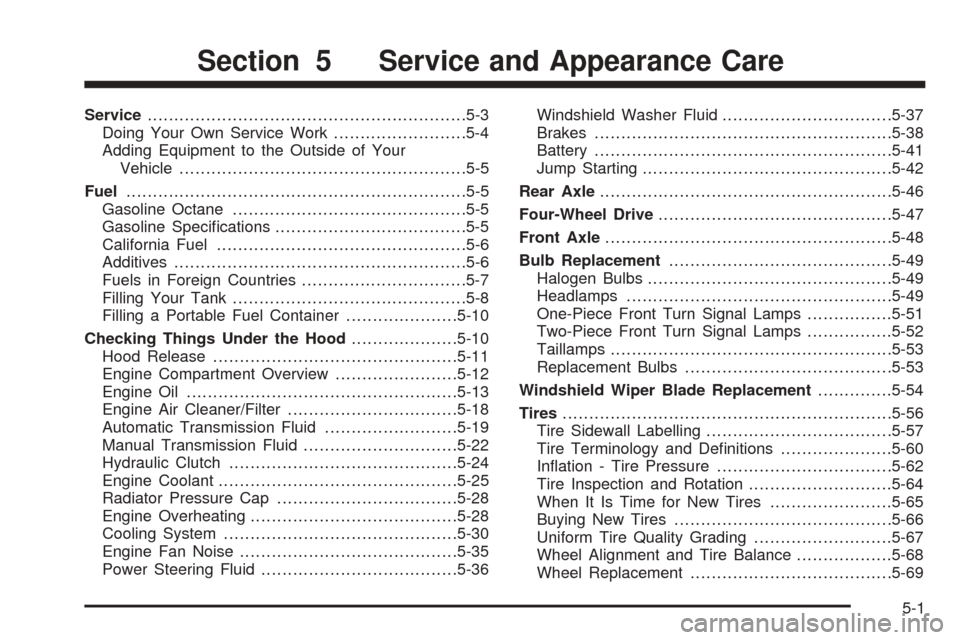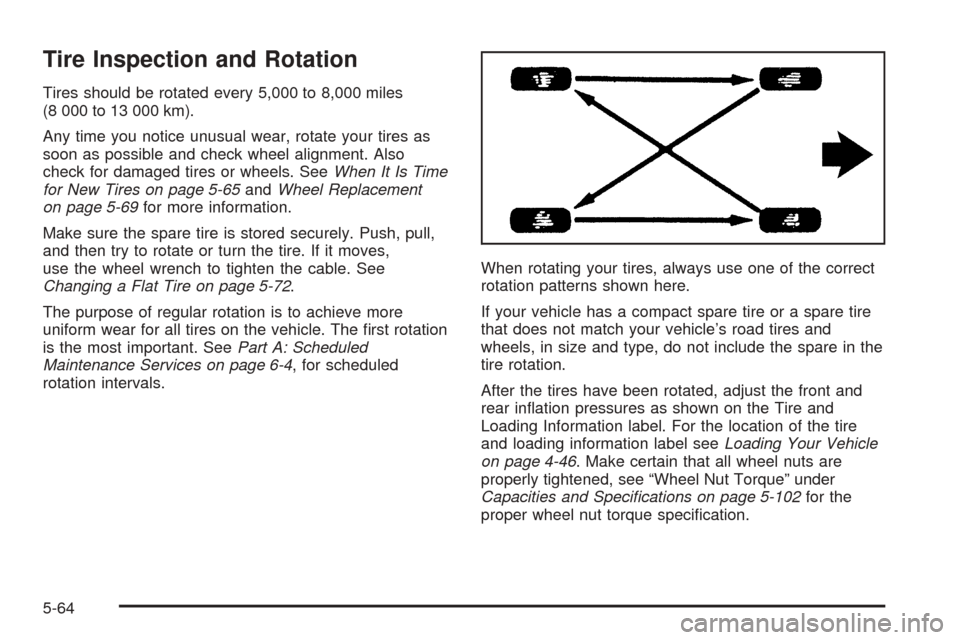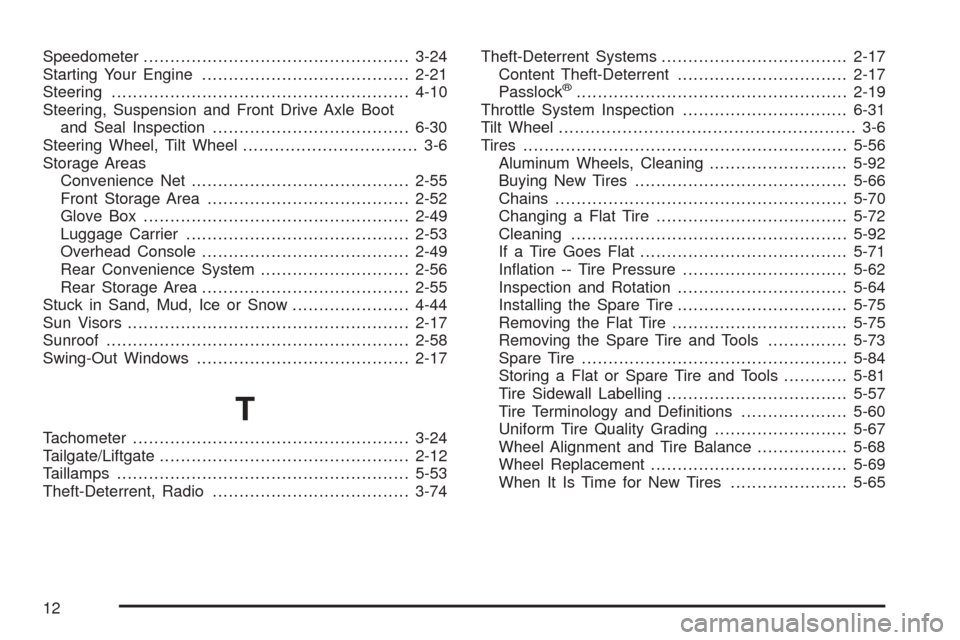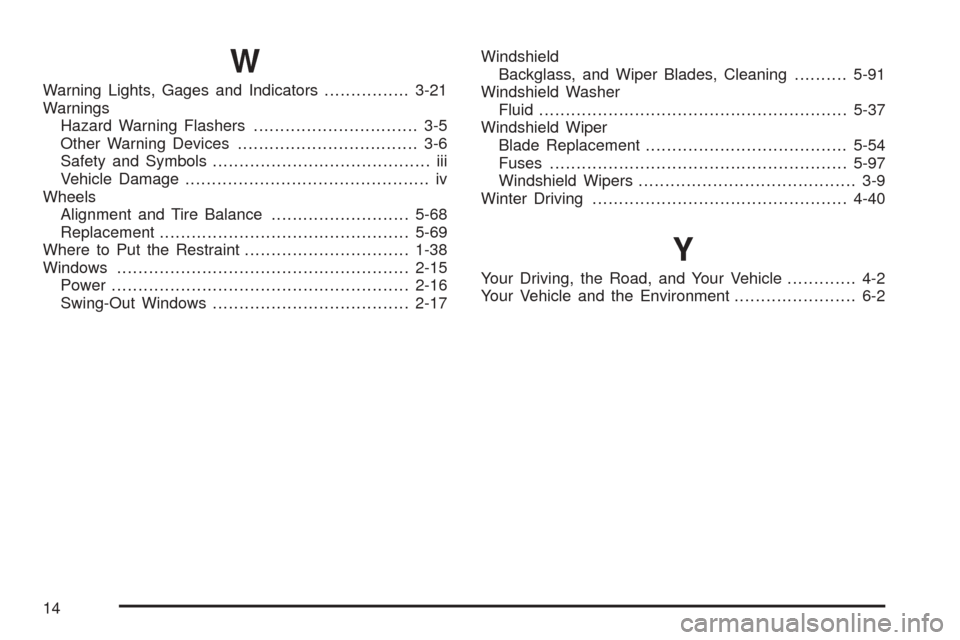wheel alignment CHEVROLET BLAZER 2005 2.G Owners Manual
[x] Cancel search | Manufacturer: CHEVROLET, Model Year: 2005, Model line: BLAZER, Model: CHEVROLET BLAZER 2005 2.GPages: 436, PDF Size: 2.55 MB
Page 273 of 436

Service............................................................5-3
Doing Your Own Service Work.........................5-4
Adding Equipment to the Outside of Your
Vehicle......................................................5-5
Fuel................................................................5-5
Gasoline Octane............................................5-5
Gasoline Speci�cations....................................5-5
California Fuel...............................................5-6
Additives.......................................................5-6
Fuels in Foreign Countries...............................5-7
Filling Your Tank............................................5-8
Filling a Portable Fuel Container.....................5-10
Checking Things Under the Hood....................5-10
Hood Release..............................................5-11
Engine Compartment Overview.......................5-12
Engine Oil...................................................5-13
Engine Air Cleaner/Filter................................5-18
Automatic Transmission Fluid.........................5-19
Manual Transmission Fluid.............................5-22
Hydraulic Clutch...........................................5-24
Engine Coolant.............................................5-25
Radiator Pressure Cap..................................5-28
Engine Overheating.......................................5-28
Cooling System............................................5-30
Engine Fan Noise.........................................5-35
Power Steering Fluid.....................................5-36Windshield Washer Fluid................................5-37
Brakes........................................................5-38
Battery........................................................5-41
Jump Starting...............................................5-42
Rear Axle.......................................................5-46
Four-Wheel Drive............................................5-47
Front Axle......................................................5-48
Bulb Replacement..........................................5-49
Halogen Bulbs..............................................5-49
Headlamps..................................................5-49
One-Piece Front Turn Signal Lamps................5-51
Two-Piece Front Turn Signal Lamps................5-52
Taillamps.....................................................5-53
Replacement Bulbs.......................................5-53
Windshield Wiper Blade Replacement..............5-54
Tires..............................................................5-56
Tire Sidewall Labelling...................................5-57
Tire Terminology and De�nitions.....................5-60
In�ation - Tire Pressure.................................5-62
Tire Inspection and Rotation...........................5-64
When It Is Time for New Tires.......................5-65
Buying New Tires.........................................5-66
Uniform Tire Quality Grading..........................5-67
Wheel Alignment and Tire Balance..................5-68
Wheel Replacement......................................5-69
Section 5 Service and Appearance Care
5-1
Page 336 of 436

Tire Inspection and Rotation
Tires should be rotated every 5,000 to 8,000 miles
(8 000 to 13 000 km).
Any time you notice unusual wear, rotate your tires as
soon as possible and check wheel alignment. Also
check for damaged tires or wheels. SeeWhen It Is Time
for New Tires on page 5-65andWheel Replacement
on page 5-69for more information.
Make sure the spare tire is stored securely. Push, pull,
and then try to rotate or turn the tire. If it moves,
use the wheel wrench to tighten the cable. See
Changing a Flat Tire on page 5-72.
The purpose of regular rotation is to achieve more
uniform wear for all tires on the vehicle. The �rst rotation
is the most important. SeePart A: Scheduled
Maintenance Services on page 6-4, for scheduled
rotation intervals.When rotating your tires, always use one of the correct
rotation patterns shown here.
If your vehicle has a compact spare tire or a spare tire
that does not match your vehicle’s road tires and
wheels, in size and type, do not include the spare in the
tire rotation.
After the tires have been rotated, adjust the front and
rear in�ation pressures as shown on the Tire and
Loading Information label. For the location of the tire
and loading information label seeLoading Your Vehicle
on page 4-46. Make certain that all wheel nuts are
properly tightened, see “Wheel Nut Torque” under
Capacities and Speci�cations on page 5-102for the
proper wheel nut torque speci�cation.
5-64
Page 340 of 436

Temperature – A, B, C
The temperature grades are A (the highest), B, and C,
representing the tire’s resistance to the generation
of heat and its ability to dissipate heat when tested
under controlled conditions on a speci�ed indoor
laboratory test wheel. Sustained high temperature can
cause the material of the tire to degenerate and
reduce tire life, and excessive temperature can lead to
sudden tire failure. The grade C corresponds to a
level of performance which all passenger car tires must
meet under the Federal Motor Vehicle Safety Standard
No. 109. Grades B and A represent higher levels of
performance on the laboratory test wheel than the
minimum required by law.
Warning: The temperature grade for this tire is
established for a tire that is properly in�ated and not
overloaded. Excessive speed, underin�ation, or
excessive loading, either separately or in combination,
can cause heat buildup and possible tire failure.
Wheel Alignment and Tire Balance
The wheels on your vehicle were aligned and balanced
carefully at the factory to give you the longest tire life
and best overall performance.
If you notice unusual tire wear or your vehicle pulling one
way or the other, the alignment may need to be reset. If
you notice your vehicle vibrating when driving on a
smooth road, your wheels may need to be rebalanced.
5-68
Page 434 of 436

Speedometer..................................................3-24
Starting Your Engine.......................................2-21
Steering........................................................4-10
Steering, Suspension and Front Drive Axle Boot
and Seal Inspection.....................................6-30
Steering Wheel, Tilt Wheel................................. 3-6
Storage Areas
Convenience Net.........................................2-55
Front Storage Area......................................2-52
Glove Box..................................................2-49
Luggage Carrier..........................................2-53
Overhead Console.......................................2-49
Rear Convenience System............................2-56
Rear Storage Area.......................................2-55
Stuck in Sand, Mud, Ice or Snow......................4-44
Sun Visors.....................................................2-17
Sunroof.........................................................2-58
Swing-Out Windows........................................2-17
T
Tachometer....................................................3-24
Tailgate/Liftgate...............................................2-12
Taillamps.......................................................5-53
Theft-Deterrent, Radio.....................................3-74Theft-Deterrent Systems...................................2-17
Content Theft-Deterrent................................2-17
Passlock
®...................................................2-19
Throttle System Inspection...............................6-31
Tilt Wheel........................................................ 3-6
Tires.............................................................5-56
Aluminum Wheels, Cleaning..........................5-92
Buying New Tires........................................5-66
Chains.......................................................5-70
Changing a Flat Tire....................................5-72
Cleaning....................................................5-92
If a Tire Goes Flat.......................................5-71
In�ation -- Tire Pressure...............................5-62
Inspection and Rotation................................5-64
Installing the Spare Tire................................5-75
Removing the Flat Tire.................................5-75
Removing the Spare Tire and Tools...............5-73
Spare Tire..................................................5-84
Storing a Flat or Spare Tire and Tools............5-81
Tire Sidewall Labelling..................................5-57
Tire Terminology and De�nitions....................5-60
Uniform Tire Quality Grading.........................5-67
Wheel Alignment and Tire Balance.................5-68
Wheel Replacement.....................................5-69
When It Is Time for New Tires......................5-65
12
Page 436 of 436

W
Warning Lights, Gages and Indicators................3-21
Warnings
Hazard Warning Flashers............................... 3-5
Other Warning Devices.................................. 3-6
Safety and Symbols......................................... iii
Vehicle Damage.............................................. iv
Wheels
Alignment and Tire Balance..........................5-68
Replacement...............................................5-69
Where to Put the Restraint...............................1-38
Windows.......................................................2-15
Power........................................................2-16
Swing-Out Windows.....................................2-17Windshield
Backglass, and Wiper Blades, Cleaning..........5-91
Windshield Washer
Fluid..........................................................5-37
Windshield Wiper
Blade Replacement......................................5-54
Fuses........................................................5-97
Windshield Wipers......................................... 3-9
Winter Driving................................................4-40
Y
Your Driving, the Road, and Your Vehicle............. 4-2
Your Vehicle and the Environment....................... 6-2
14